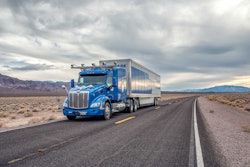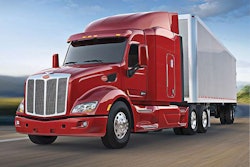This story was originally published in February 2018.
 Bruce and Heather Richards’ 2016 Volvo features a 168-inch ARI sleeper.
Bruce and Heather Richards’ 2016 Volvo features a 168-inch ARI sleeper.Some of the best things about coming home from a long trip on the road are being able to cook your own food, stretch out comfortably to watch TV on a good-sized screen, and not have to walk across a parking lot to use the bathroom.
Those benefits come every day on the road for owner-operators running with a custom sleeper. Most feature kitchens with a refrigerator and freezer, stove top burner, microwave and sink. Most also have bathrooms that include a shower and toilet.
At a cost of $200,000 to $300,000, if not more, a new truck with a custom sleeper isn’t something for a novice owner-operator, but the amenities are worth it for many who spend a lot of time away from home.
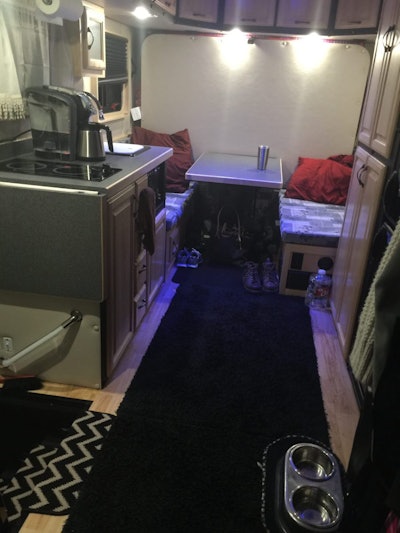 Bruce and Heather Richards’ 168-inch sleeper features a queen-size bed that folds down where the dining table is, along with common custom sleeper amenities such as a sink, stove top, refrigerator and more.
Bruce and Heather Richards’ 168-inch sleeper features a queen-size bed that folds down where the dining table is, along with common custom sleeper amenities such as a sink, stove top, refrigerator and more.

“The easiest way to buy one is to get one of the cookie-cutter models with all the options,” says Bruce Richards, who’s leased to Florida-based Southern Pride Trucking. “To build a custom one, you start at a dealer, sit down with them and tell them what you want and how you want it, then they order the chassis and send it to ARI. They build the sleeper, send it back to the dealer, and you purchase the entire rig from the dealer.”
[Related: Team owner-operators’ unique path to trucking success]
Richards and his wife, Heather, own a 2016 Volvo with a 168-inch ARI sleeper. Bruce says his first truck with a custom sleeper was a company truck, then he had a custom sleeper built for his Western Star. Now he’s in his biggest sleeper yet, which includes a full-size kitchen, a queen size bed and “all the luxuries of home.” The customized Volvo cost around $250,000 when he bought it in 2016.
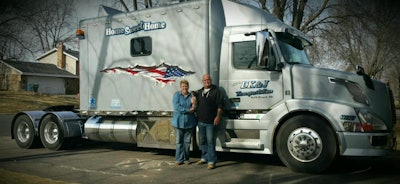 Dan and Joy Kelly’s custom ARI sleeper in their 2013 Volvo features a 144-inch custom sleeper.
Dan and Joy Kelly’s custom ARI sleeper in their 2013 Volvo features a 144-inch custom sleeper.
When a new-truck buyer wants a custom sleeper, the sleeper shop works closely with the truck dealers to ensure proper placement and specs for the wheelbase, frame rails, etc. All financing, including for the sleeper, is done through the truck dealer.
[Related: Custom champs: Despite tough 2020, Daniel & Phyllis Snow persevere]
On an existing truck, the sleeper shop works with whomever stretches the wheelbase to ensure the addition fits properly.
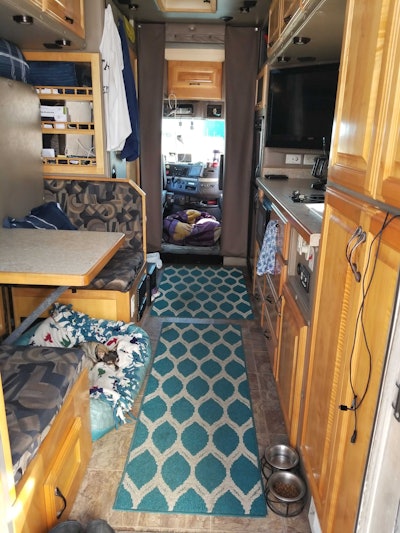 The Kelly’s rig includes a dining booth area, which converts to a bed when the bunk folds down from the wall. It also has a sink, two-burner stove, large refrigerator with separate freezer, shower and toilet.
The Kelly’s rig includes a dining booth area, which converts to a bed when the bunk folds down from the wall. It also has a sink, two-burner stove, large refrigerator with separate freezer, shower and toilet.
Adding a custom sleeper can take six weeks to three months, customizers say, though some truck dealers stock new and used trucks with custom sleepers, ARI says.
“We have dealers that keep between three and 10 units in stock at a time,” Miller says. “They’re built in the same manner as if you walked into our front door and ordered one. They’re well-spec’d and ready to go.”
Milham says one of the most-requested features in recent years has been two-burner stove tops, sought by drivers interested in cooking lots of their own meals, often for health reasons. Cabinet space also is in big demand, and many customers will sacrifice features, such as a larger bed, to have more cabinets. Most drivers also choose to have an in-motion satellite TV system installed, he says.
Truckers Greg and Danelle Swafford, based in Alabama and leased to Mercer, were preparing to customize a sleeper for a new truck but changed their minds when they found a 2016 Western Star 5700 with a 132-inch ARI sleeper already installed.
“There are a couple things I may have done differently,” Greg Swafford says, “but we’re very happy with this truck.”
[Related: Custom champs: Chris Kulow's 2007 Peterbilt 379]
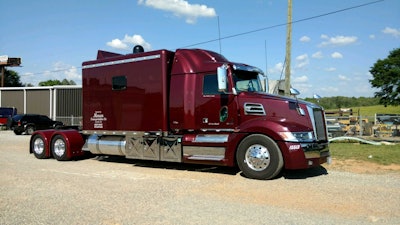 Greg and Danelle Swafford’s 2016 Western Star 5700 features a 132-inch sleeper.
Greg and Danelle Swafford’s 2016 Western Star 5700 features a 132-inch sleeper.
ARI’s Legacy II sleepers are the company’s floorplan models, which can be customized. These are typically a better value, Miller says, because all of the engineering is complete and the plant builds them more efficiently than a fully customized unit.
Dan and Joy Kelly, leased to Landstar and based in Minnesota, own a 2013 Volvo with a 144-inch ARI sleeper.
“You pick out your flooring, walls, fabric, cushions, wood for cupboards, everything – just like designing your home,” Joy says. “We ordered the truck from the factory with a 302-inch wheelbase. They order a day cab, then ARI does the extra work.”
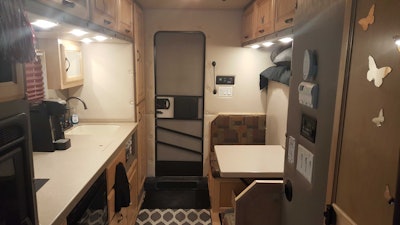 The sleeper on the Swaffords’ truck has a back door that opens onto the catwalk. The shower is near the cab. The Alabama-based couple hauls military equipment.
The sleeper on the Swaffords’ truck has a back door that opens onto the catwalk. The shower is near the cab. The Alabama-based couple hauls military equipment.Their truck cost $235,000 when they purchased it in 2013. The sleeper includes a sink, two burner stove, big refrigerator with a separate freezer, booth-style table, foldup bed, shower, toilet, 32-inch flat-screen TV and more.
It’s truly a home on wheels because they sold their house. “It’s our money-making motor home,” Joy says. When they visit their hometown a few times a year, they stay with Dan’s mother.
[Related: The big-bunk ‘Low Budget Lounge’ of Missouri-based SPB Trucking]
Consider length and weight
The big price tag isn’t the only thing to give pause to a prospective custom sleeper buyer. The longer wheelbase and extra weight not only hurt fuel economy, they also can be problematic for certain applications.
Greg Swafford says he doesn’t run into New York City because of the difficulty of maneuvering his Western Star 5700 with a 132-inch sleeper. Also, laws in Canada restrict tractor-trailers to 75.5 feet, which leaves only 270 inches for the tractor’s wheelbase when coupled with a 53 foot trailer.
If you tend to max out your weight when loaded, consider how much a custom sleeper will reduce your capacity. The average factory sleeper weighs around 1,500 pounds, ARI’s John Miller says. A 156-inch sleeper, which he says is currently the company’s most popular size, would bring the sleeper total to about 5,000 pounds.
ICT’s Tommy Milham says drivers can control weight by picking lighter features such as aluminum cabinets with a vinyl cover instead of solid wood cabinets, or by skipping options such as a second water tank, which many husband-wife teams prefer so they can go longer between water refills.
[Related: 'Eighth house truck' for Rick and Terry Henderson]
Recreational trucking
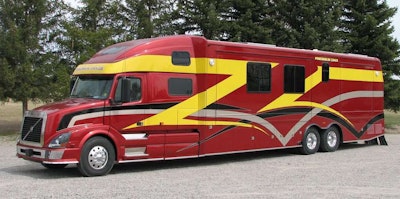 Powerhouse Coach transforms a Class 8 tractor into an RV. The high-end rigs take a minimum of six months to build.
Powerhouse Coach transforms a Class 8 tractor into an RV. The high-end rigs take a minimum of six months to build.
Powerhouse Coach is a small operation that started 20 years ago when owner Doug Tolbert, who has a towing and trucking background, converted his first rig into an RV.
“I bought the truck from my dad and rebuilt it,” he says. “When people saw it, they wanted one, and we’ve been building them for 20 years now.”
All of Powerhouse Coach’s trucks are built custom to order from the ground up. Tolbert says the trucks feature all the amenities of a high-end RV. Anything that can be put in an RV, he says, can be put on a truck.
Powerhouse Coach’s typical creations come at a hefty price, though, and with the size of the trucks, they generally are only for recreational purposes. Tolbert says his trucks start out around $250,000 and can range to $900,000 or more.
Because Class 8 trucks are built to spend the majority of their time driving on the highway rather than sitting in a campground, Powerhouse’s rigs are safer than a standard RV, Tolbert says. “If you’ve ever seen a crash with an RV, you know it looks very scary and unsafe,” he says.
The trucks take around six to nine months to build, sometimes up to a year, Tolbert says. “It’s me and three guys. We build about one-and-a-half rigs a year.”
[Related: Custom 2021 Peterbilt 'home away from home' with a 168-inch ARI big bunk]


